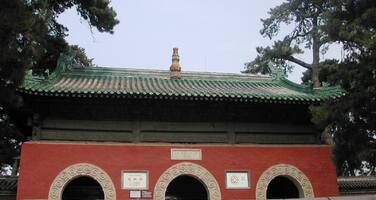Mountain Resort and its Outlying Temples, Chengde
Factors affecting the property in 1998*
- Air pollution
- Housing
- Impacts of tourism / visitor / recreation
- Management systems/ management plan
- Other Threats:
Many buildings in a bad state of conservation
Factors* affecting the property identified in previous reports
- Bad state of conservation of many buildings
- Need to better manage visitors
- Urban development project
- Air pollution
International Assistance: requests for the property until 1998
Total amount approved : 34,150 USD
| 1995 | Training Course in the Mountain Resort and its Outlying ... (Approved) | |
| 1995 | Purchase of additional security equipment for Chengde ... (Approved) | 34,150 USD |
Missions to the property until 1998**
September 1996: UNESCO expert mission
Conservation issues presented to the World Heritage Committee in 1998
The Bureau, at its twentieth extraordinary session in 1996, recommended that the Chinese authorities adopt a development plan for the town of Chengde in line with World Heritage conservation needs. The Chinese authorities reported to the Secretariat, in a state of conservation report on this property submitted in July 1998, that the city planning department has included World Heritage protection in the historic city’s urban development plan.
According to this report, conservation work has continued since its inscription on the World Heritage List in 1994. A 10-year Renovation Plan of the site was prepared by national experts and approved by the Bureau of Cultural Relics of Chengde City in 1995. An “Overall Management Plan for Chengde City” was adopted by Hebei Provincial Government in 1995. Afforestation measures have been taken for the gardens and the surroundings of the site, with vegetation coverage currently exceeding 90%.
Training and education activities carried out by the site administration have enabled the training of more than 3,500 persons. Promotion “week” and “month” were organized by the City Government to increase the understanding and application of the Law on the Protection of Cultural Relics. Chengde Research Institute of Cultural Properties was established in 1995. Over 30 on-site staff have been trained at other institutes or universities. With assistance from the World Heritage Fund, a Training Course for Site Managers of Cultural World Heritage Properties in China was organized in September 1997 by the State Bureau of Cultural Relics. In addition, the Mayor of Chengde participated in the International Conference for Mayors of Historic Cities in China and the European Union in April 1998 (Suzhou) organized by the World Heritage Centre and exchanged experiences with counterparts from China and the EU.
Security conditions at the site museum have improved, thanks to the technical and equipment support made available from the World Heritage Fund. The security staff has increased from 200 to 300 persons since 1995. 3.4 million RMB Yuan (USD411.600) was invested in the restoration project of Xu Mi Fu Shou Temple and the conservation of artifacts in the site museums.
The management of the site has been strengthened with the Vice-Mayor of Chengde City assuming the responsible supervision of all administration work. A decision was taken to further intensify the protection of the site by the City government so as to strengthen the implementation of the Management Plan.
The Bureau was informed by the World Heritage Centre of reports received concerning increasing urban and tourism development pressures negatively affecting the historical setting within the buffer zone of this site.
The Bureau took note of the state of conservation report submitted by the Chinese authorities and commended the local authorities for their efforts in enhancing the management of the site. The Bureau, however, expressed concern over the rapidly increasing urban pressure within the buffer zone and encouraged the relevant authorities to take appropriate measures to integrate tourism development and urban heritage conservation issues in the Management Plan of the site.
Summary of the interventions
Decisions adopted by the Committee in 1998
22 COM VII.43
Reports on the State of Conservation of Cultural Properties Noted by the Committee
VII.43 The Committee noted the decisions of the twenty-second extraordinary session of the Bureau as reflected in the Report of the Bureau session (Working Document WHC-98/CONF.203/5) and included in Annex IV of this report on the following properties:
Rapa Nui National Park (Chile)
The Mountain Resort and Its Outlying Temples in Chengde (China)
The Potala Palace, Lhasa (China)
Temple and Cemetery of Confucius and the Kong Family Mansion in Qufu (China)
Ancient Building Complex in the Wudang Mountains (China)
City of Quito (Ecuador)
Memphis and its Necropolis - the Pyramid Fields from Giza to Dahshur (Egypt)
Ancient Thebes with its Necropolis (Egypt)
Islamic Cairo (Egypt)
Historic Centre (Old Town) of Tallinn (Estonia)
Collegiate Church, Castle and Old Town in Quedlinburg (Germany)
Historic Centre of Florence (Italy)
Quseir Amra (Jordan)
Luang Prabang (Laos)
Baalbek (Lebanon)
Tyre (Lebanon)
Vilnius Historic Centre (Lithuania)
Old Towns of Djenné (Mali)
City of Cusco (Peru)
Archaeological site of Chavin (Peru)
Historic Centre of Lima (Peru)
The Baroque Churches of the Philippines (The Philippines)
Historic Centre of Porto (Portugal)
Island of Gorée (Senegal)
Sacred City of Anuradhapura (Sri Lanka)
Ancient City of Polonnaruva (Sri Lanka)
Ancient City of Sigiriya (Sri Lanka)
Site of Palmyra (Syrian Arab Republic)
Historic Areas of Istanbul (Turkey)
Kiev: Saint Sophia Cathedral and Related Monastic Buildings (Ukraine)
Complex of Hué Monuments (Vietnam)
Old City of Sana'a (Yemen)
No draft Decision
* :
The threats indicated are listed in alphabetical order; their order does not constitute a classification according to the importance of their impact on the property.
Furthermore, they are presented irrespective of the type of threat faced by the property, i.e. with specific and proven imminent danger (“ascertained danger”) or with threats which could have deleterious effects on the property’s Outstanding Universal Value (“potential danger”).
** : All mission reports are not always available electronically.


